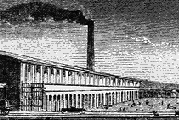|
________________________________________________________ The growth model of Evsey Domar (1946, 1947) follows a different route to that of Roy Harrod's to reach a similar end. Domar is interested in finding "the rate of growth of national income which the maintenance of full employment requires" (Domar, 1947: p.84). Domar pays particular attention to the "dual character of the investment process" (1947: p.89) -- namely, that increasing investment raises aggregate demand while at the same time increases the productive capacity of an economy. Domar concentrates on the details of the "race" between capacity construction and aggregate demand growth. In this respect, Domar is perhaps closer to the "Continental tradition" of Aftalion, Fel'dman and the Kiel School than he is to Harrod himself. From the macroeconomic equilibrium condition, S = I, we obtain the simple result that, in equilibrium,
Consequently, any increase in investment, by the multiplier, translates to an increase in aggregate demand and thus output, i.e. at an instant in time:
But investment also increases the "capacity" or "potential output" of the economy. Denoting P as potential output, then let us define:
as the ratio of capacity, P, to capital, K. Thus, s is the potential output-capital ratio. Differentiating with respect to time, we obtain:
or simply:
so as investment increases, it will increase the capacity output P by some fraction s. Let us define the rate of capacity utilization as the output-potential output ratio, i.e.
Now, Domar defines steady-state growth as the growth rate that keeps capacity utilization constant, i.e. where gu = 0, so gY = gP or:
or:
Note that this steady-state growth condition is compatible with full employment (i.e. when P = Y, so u = 1) or unemployment (P > Y, so 0 < u < 1). Thus, it is possible to reconcile steady-state growth with a constant amount of unemployment. Nonetheless, without loss of generality, we assume steady-state full employment growth, and thus impose that u = 1 in our desired steady-state. This simplifies our condition to merely dY/dt = dP/dt. By substitution from our earlier terms, we obtain Domar's fundamental equation:
which can be rewritten as:
which is a simple linear first order differential equation. Finding the solution is elementary. By integration:
where I0 is the initial investment rate. It is immediately obvious that s s is the rate of growth of investment in steady-state. We shall refer to s s as the required rate of investment growth. So, investment must grow at the exponential rate s s in order to keep capacity utilization constant. The question Domar posed was what would happen if the actual rate of growth is different from required rate, ss? To illustrate, assume that investment, in reality, grows at exponential rate r:
It is easy to verify that income Y(t) grows at the same rate. Specifically, differentiating this with respect to time:
then, by macroeconomic equilibrium, we know that dY/dt = (1/s)dI/dt, thus we now have:
as, again by macroeconomic equilibrium, Y = (1/s)I = (1/s)I0ert, then:
which is a simple first order differential equation which, upon solving, yields:
so gY = gI = r by macroeconomic equilibrium. Now, by the capacity construction equation dP/dt = sI, so substituting in:
Thus: (dY/dt - dP/dt) = (r/s - s )I0ert Thus, we only have steady-state equilibrium (dY/dt = dP/dt) if r/s = s . Or, put in other words, if the actual rate of growth (r) is not equal to the required rate (s s), then capacity will change. Specifically:
The first result implies that u ® ¥ over time if r > s s. This may sound bizarre as utilization should not be able to exceed 1 ("full capacity utilization"). But u > 1 merely means that aggregate demand far exceeds capacity -- an inflationary situation. The connection between Harrod's and Domar's models can be easily made if we think of s = 1/v, so that the steady-state condition fits neatly, namely r = s/v. Thus the solution in both models is the same, even though arrived at by different means. (cf. Harrod, 1959). Note also that the Harrodian knife-edge is present in Domar's model: unless the actual investment growth rate r is equal to s s, the system is unstable. If r > s s, then aggregate demand growth outstrips capacity growth and increasingly so. Similarly, if r < s s, aggregate demand cannot keep up with the capacity that is created so that we collapse to zero capacity utilization. The intuitive logic is not difficult to understand. If an entrepreneur perceives that r > ss (i.e. demand is growing very rapidly), he will seek to increase his capacity. The only way of doing so would be to increase investment and thus aggregate demand further -- implying that r would increase even further away from ss. Conversely, an entrepreneur facing r < s s sees aggregate demand grow relatively slowly and thus, expecting to face excess capacity, he will cut back plans for new investment -- reducing aggregate demand further and making the divergence even greater.
|
All rights reserved, Gonçalo L. Fonseca

